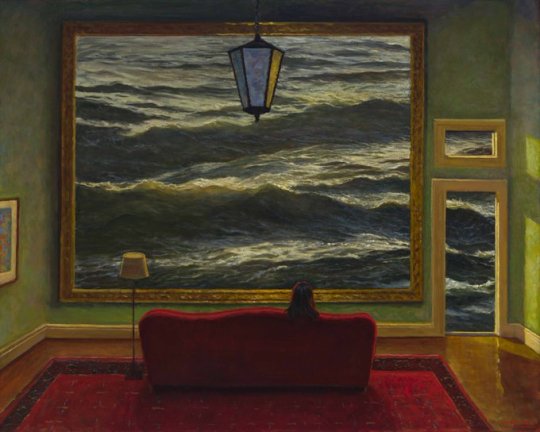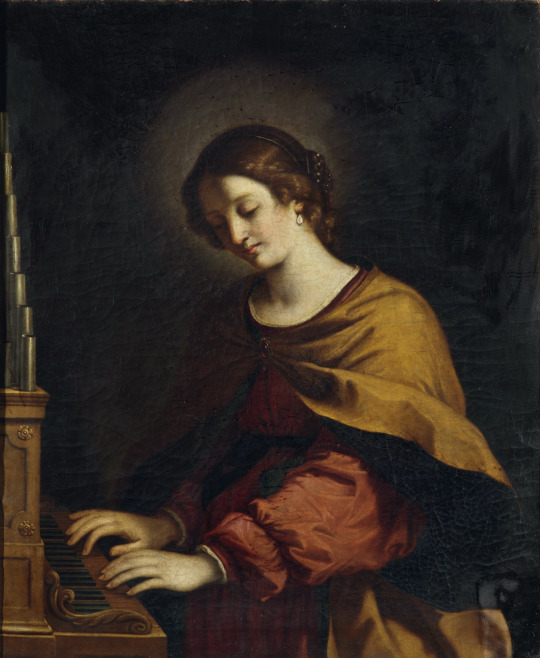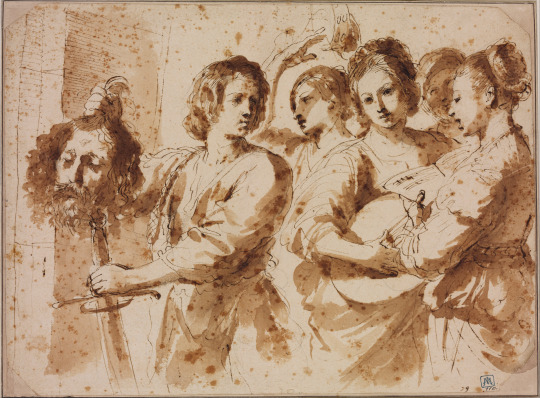Photo

The House of Death, William Blake, 1795, Tate
date inscribed Presented by W. Graham Robertson 1939
Size: support: 485 x 610 mm
Medium: Colour print, ink and watercolour on paper
http://www.tate.org.uk/art/artworks/blake-the-house-of-death-n05060
79 notes
·
View notes
Photo
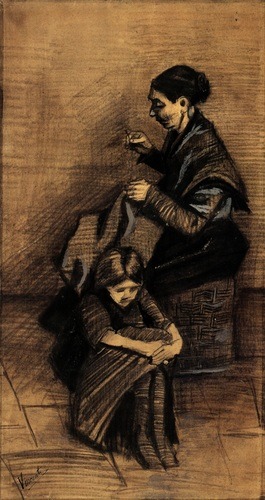
Woman Sewing, with a Girl, 1883, Vincent van Gogh
Medium: chalk,ink,watercolor,paper
18 notes
·
View notes
Photo
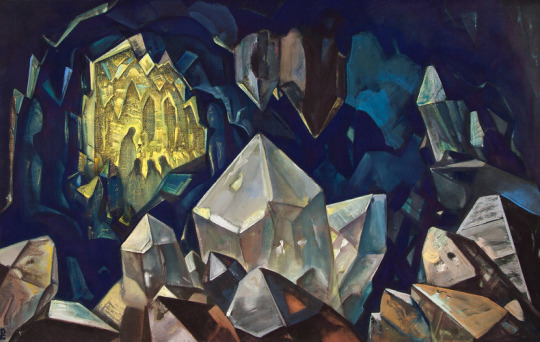
Sacred (Treasure of Mountain), 1933, Nicholas Roerich
172 notes
·
View notes
Photo

Christ in the Sepulchre, William Blake
https://www.wikiart.org/en/william-blake/christ-in-the-sepulchre
60 notes
·
View notes
Photo

The Four Seasons, Kano Tan’yū, 1668, Cleveland Museum of Art: Japanese Art
Tan'yū’s skills were honed early within the regimen of the Kano family’s painting studio. His grandfather, Eitoku (1543–1590) was the Momoyama period’s most sought-after painter, a champion of colorful, large-scale painting compositions who worked for several of the country’s most powerful leaders. When the young Tan'yū was summoned to Edo in 1617 by the shogun to become a member of the new capital’s official painting studio, few opportunities to work on similarly ambitious projects existed. Yet by the end of his career, Tan'yū had supervised the execution and installation of linked mural painting compositions in several of Japan’s most prestigious residences and castles. As an official court painter to the first shogun, Tokugawa Ieyasu (reigned 1603–5), and then his successors, Tan'yū appears to have successfully juggled his official duties with private activities as a teacher, as the era’s leading connoisseur of classic Chinese and Japanese painting, and as a practicing artist. His surviving compositions as well as thousands of sketches far surpass the oeuvre of any of his contemporaries. While studio assistants surely contributed to his oeuvre, just as later imitators consciously confused his accomplishments, a clearer image of the painter has emerged in recent years that better conforms with his contemporary acclaim as recorded in seventeenth- and eighteenth-century documents.
Tan'yū can now be seen as an artist adept in virtually all traditional ink painting subject matter, which he often presented in novel interpretations. Equally important are his rare screen (byōbu) compositions executed in a pure yamato-e manner with vivid mineral pigments on a gold-foil background. This pair of byōbu presents Tan'yū’s more orthodox approach to academic ink painting methods embracing Chinese themes that had been interpreted by numerous Japanese ink painters over the centuries. Thus a typical view of residences and human activities set along the shores of an impressive river (or lake) is enlivened by the Japanese proclivity for including seasonal references. Proceeding from right to left, the viewer passes sequentially from spring to the snow-laden branches of winter.
Tan'yū lends considerable atmospherics to the panorama in his use of misty cloud banks, frequently set off by sharp, darkened ink lines or whole areas of ink washes of variegated tonalities. The spring and summer views are particularly notable in this regard, as is the presence of the artist’s signature on both byōbu, attesting to their completion in Tan'yū’s sixty-seventh year (1668)—50 years after he left Kyoto for the capital, and 30 years following his adoption of the artist name “Tan'yū” (in 1635). From 1622, when he began work on the mural paintings for Edo castle (the shogun’s formal residence), through the completion of the painting cycle in 1636 for the Tokugawa family mausoleum in Nikkō to the north of Edo, Tan'yū’s skills as head of an accomplished painting studio as well as a master painter found their most impressive expression in large-scale compositions. In 1638 he received the honorary Buddhist title Hōgen (Eye of the Law). It is intriguing therefore that relatively few independent byōbu paintings from the master’s hand survive, particularly documented early works.
Size: Image: 174 x 381 cm (68 ½ x 150 in.)
Medium: Six-panel folding screen, ink and slight color on paper
https://clevelandart.org/art/1992.394.1
22 notes
·
View notes
Photo

Key Latch, 1st–7th century, Metropolitan Museum of Art: Medieval Art
Purchase, De Souhami Collection, Rogers Fund, 1906
Size: Overall: 2 9/16 x 13/16 x 3/16 in. (6.5 x 2.1 x 0.5 cm)
Medium: Iron
https://www.metmuseum.org/art/collection/search/462987
22 notes
·
View notes
Text
Forgotten Artist: Phoebe Anna Traquair (1852-1936)
I recently stumbled upon an artist of real interest. Actually I have known one work of hers for some time now: The Progress of the Soul… her stunning four-panel tapestry… yet the work was wrongly attributed on the website from which I had originally downloaded the image (No wonder I couldn’t find any other works of a similar nature by this marvelous artist).
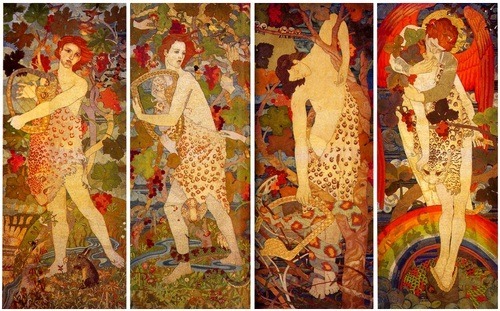
Phoebe Anna Traquair was a multi-talented artist associated with the Celtic Revival/Scottish Renaissance in Arts and Crafts of the early twentieth century. Although she was considered a Scottish artist, Traquair was actually born in Dublin, Ireland. She attended the School of Design in Dublin before moving to Edinburgh in 1874, after her marriage to Dr Ramsay Traquair, who was later appointed “Keeper of Natural History” at Edinburgh’s Museum of Science and Art in 1874.
Phoebe was influenced by the Pre-Raphaelites, William Morris and the Arts and Crafts Movement, William Blake, and the Italian painters of the early Italian Renaissance (the period from which the “PreRaphaelites”… before Raphael… took their name). She was a correspondent of John Ruskin, a friend of William Holman Hunt, and pursued a successful career as an artist, designer, and craft worker achieving an international recognition.
Among the staggering body of work completed over the course of her career, Traquair produced a good number of traditional paintings on canvas or panel:
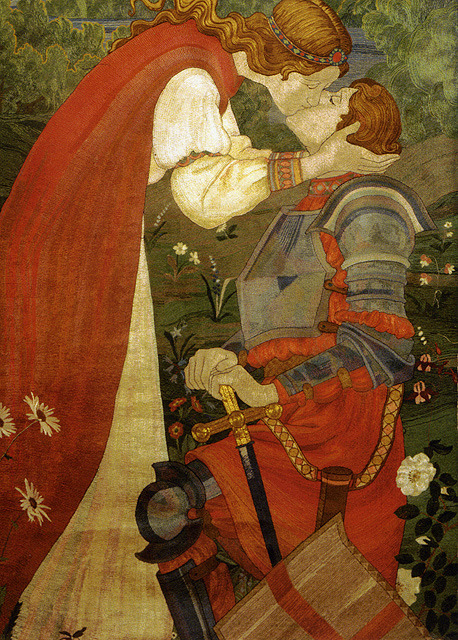

A lover of literature, Phoebe created a number of illuminated manuscripts… including this marvelous work, illustrating the Sonnets from the Portuguese of Elizabeth Barrett Browning:
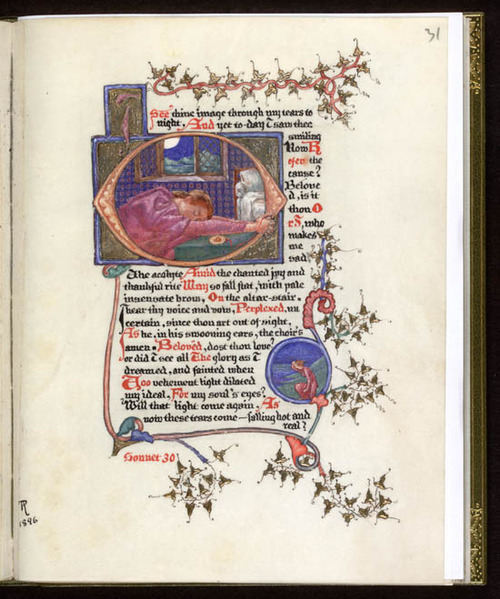
Among her decorative paintings, there is the Grand Piano for the Great Hall at Lympne Castle, Kent:

An incredibly skilled embroiderer, Traquair produced a body of stunning tapestries, including the Salvation of Mankind:

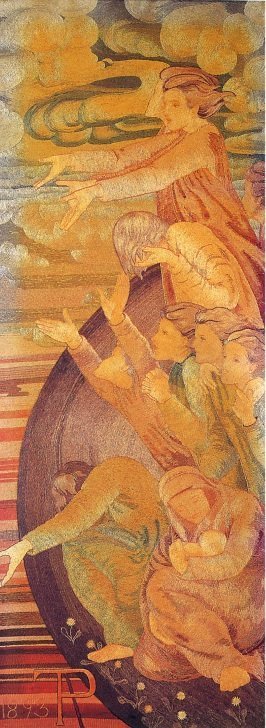
In a letter to her nephew, Traquair writes:
“To the artist, be he the poet, painter or musician, the world is a great treasure house, stored with endless material for him to use, teach yourself to match the beauty of red-lipped buds, sunlight through green leaves, the yellow gorse on the hill, the song of the wild birds, so on, step by step, the world opens out. This is life. This is to live, the perfection comes when one’s own life is in harmony with this beauty”
This sentiment clearly echoes those of Walter Pater, the critic and champion of the art pour l'art movement:
“Every moment some form grows perfect in hand or face; some tone on the hills or the sea is choicer than the rest; some mood of passion or insight or intellectual excitement is irresistibly real and attractive to us, — for that moment only. Not the fruit of experience, but experience itself, is the end. A counted number of pulses only is given to us of a variegated, dramatic life. How may we see in them all that is to seen in them by the finest senses? How shall we pass most swiftly from point to point, and be present always at the focus where the greatest number of vital forces unite in their purest energy?
To burn always with this hard, gemlike flame, to maintain this ecstasy, is success in life… While all melts under our feet, we may well grasp at any exquisite passion, or any contribution to knowledge that seems by a lifted horizon to set the spirit free for a moment, or any stirring of the senses, strange dyes, strange colours, and curious odours, or work of the artist’s hands, or the face of one’s friend. Not to discriminate every moment some passionate attitude in those about us, and in the very brilliancy of their gifts some tragic dividing of forces on their ways, is, on this short day of frost and sun, to sleep before evening. With this sense of the splendour of our experience and of its awful brevity, gathering all we are into one desperate effort to see and touch, we shall hardly have time to make theories about the things we see and touch…”
-from the Conclusion to The Renaissance; Studies in Art and Poetry
The work by Traquair that I first stumbled upon… and which I still consider to be her singular masterpiece… is the four-panel tapestry, The progress of the Soul, the imagery of which was based upon the short story by Walter Pater, Denys l'Auxerrois. The work is a heady mixture of Christian and Pagan imagery and was begun as as ‘homage’ to the memory of Walter Pater who had died a year before. Traquair started the panels, though at the time, the family tried to downplay the any link with Traquair’s embroidered panels.

Traquair spent the years 1895-1902 working on the four-panel tapestries. There is no suggestion of the use of assistants which makes the achievement… considering the entire 4 panels measure 6 x 10 feet… quite impressive. The work has been described as representing the odyssey of the human soul… here an ideal young man dressed in animal skin and in harmony with the natural world around him… as it/he travels through four stages of life: In The Entrance, he is full of hope and enthusiasm, blissfully ignorant of life’s realities. The panels follow him through Stress and Despair to Victory, the last embroidery in the series. The young man himself was recognized as having been based upon the character of Denys l’Auxerrois from Imaginary Portraits by Water Pater.
Delving deeper into the iconography, I have found that it is impossible… and probably wrong-headed to attempt to read any definitive, specific, clear, linear narrative to the tapestry. Still… we can come to our own interpretations, can we not? Let us look at the first panel…
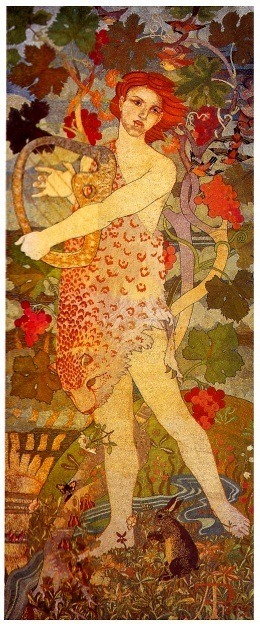
The central figure appears to be as a young man, though he’s sufficiently androgynous, feminized in appearance… typical of the influence of the female figures in early Pre-Raphaelite painting… but also common to the ideal beautiful males of Renaissance painting (as in the St. Matthew in DaVinci’s Last Supper, which Dan Brown ignorantly argued was Mary Magdalene). You could easily take the figure to be female as well as male… and I admit to having looked at the work both ways.
Of course the beautiful, golden-haired, beardless young man with a lyre immediately draws to mind both Apollo… and his brother/compliment: Dionysus, the God of wine, passion, and ecstasy. One might even imagine him as Orpheus, the legendary musician known for his lyre, who was torn to pieces by the Bacchants, adherents of the cult of Dionysus. The link with Dionysus may have been inspired in part by Titian’s masterpiece, Bacchus and Ariadne, housed in the National Gallery of Art, London. Further iconography: the grape vines and the leopard skin reinforces the connection with Dionysus.
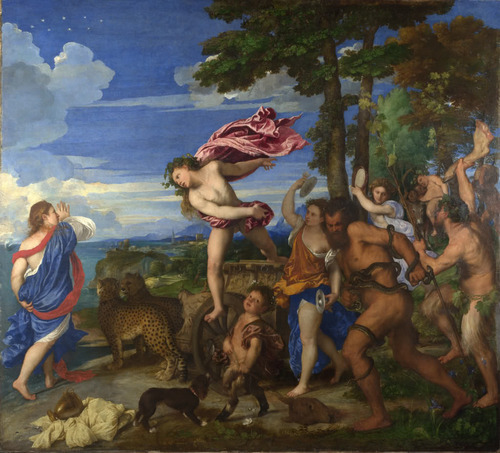
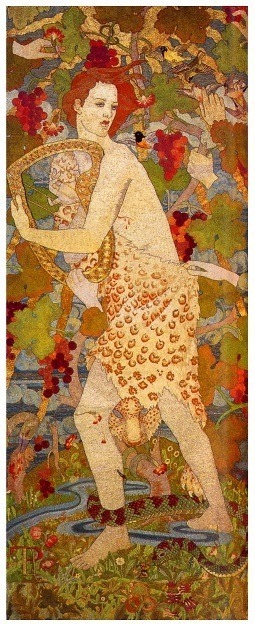
In the second panel a serpent (Python, the earth-dragon of Delphi, and Apollo’s enemy in the underworld) encircles “Apollo’s” feet, while disembodied hands grasp at at pluck the flowers, the birds, the lyre, his animal skin, and the grapevine. The grape vine is broken, flowers plucked, birds killed… and a swan… a bird once sacred to Apollo… savagely bloodies and kills the rabbit from the first panel.

In the third panel we are presented with a tragic view of the aftermath of Apollo/Dionysus/Orpheus/Christ’s travails: his leopard skin cloak is torn; Python (now doubled in size) encircles his exhausted body; his hair has become dark as the mood; the grape vines are contrasted with briers and thorns at his feet, the birds look down sadly from above… and his lyre… the instrument of his artistic creation… is now broken.

In the final panel he is presented victorious… in a moment of apotheosis… his feet placed upon a rainbow above the Python. His head encircled in a crown of grape leaves he is embraced, held aloft, and kissed by an angel.

But one questions is this a victory through death? Is it an expression of the misunderstood artist… the lover of beauty… attacked by those disembodied hands? The outcome of the Victory is not that they went on to live happily ever after. Quite to the contrary: several critics understand the Victory to be a passionate union in death. And then there are the unmistakable homoerotic undercurrents. As a result of Oscar Wilde’s very public trial and sentencing, Walter Pater was placed under a good deal of scrutiny, and was the target of much criticism and hate.
This tapestry, brilliantly colored and woven with gold and silver metallic thread, reminds me of the paintings of various Post-Impressionists… including the Nabis and Gauguin:

-Maurice Denis- Saintly Women at Christ’s Tomb
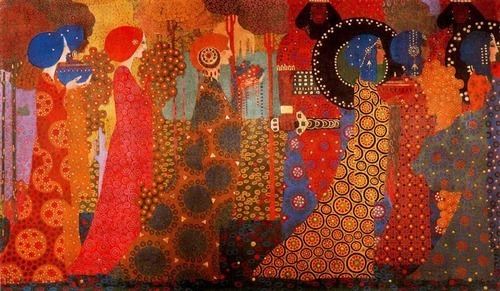
-Vittorio Zecchin- Le Mille e una Notta (One Thousand and One Nights)
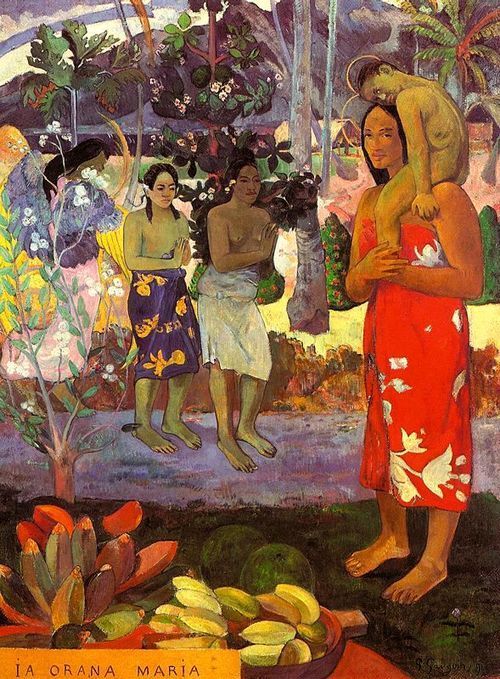
-Paul Gauguin- Ia Orana Maria (Hail Mary)
As much as I admire The Progress of the Soul, I recognize that it is Traquair’s mural work that has most served to assure her place in the history of art. The artist painted murals for various religious and charitable institutions. Kellie Castle in Fife dates from as early as the 14th century and has magnificent plaster ceilings, painted paneling and fine furniture designed by Sir Robert Lorimer, a close friend of Traquair. The castle also includes one of the artist’s first murals… clearly inspired by the works of Botticelli and Fra Filippo Lippi:
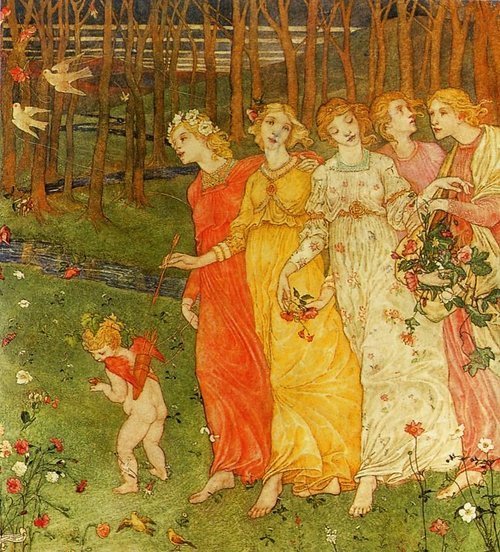
In the only mural project by Traquair realized outside of Scotland, the artist painted a series of images in St Peters Church, Clayworth, Nottinghamshire:
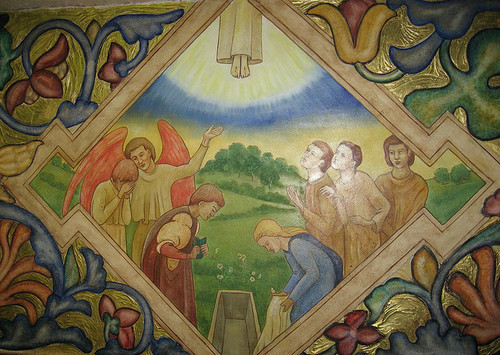
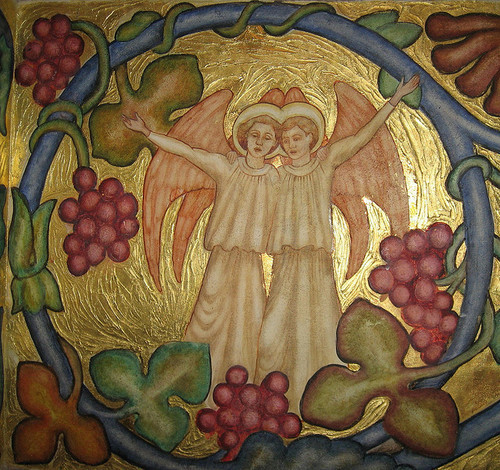

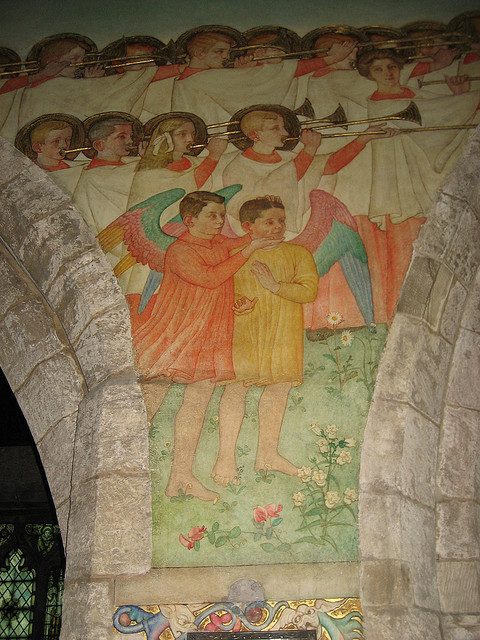
Traquair painted the interiors of four Edinburgh buildings between 1885 and 1901. The Song School of St Mary’s Cathedral (1888–92) earned Traquair a degree of national recognition. Within a tunnel-vaulted interior, the east wall depicts the cathedral clergy and choir.
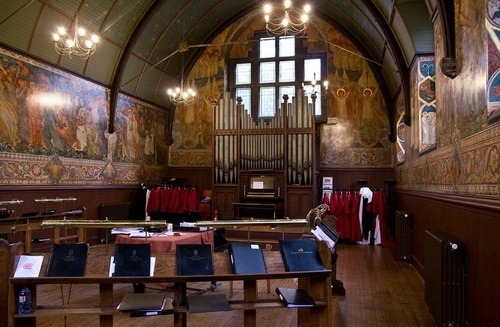
The south wall depicts Traquair’s admired contemporaries such as Dante Gabriel Rosetti, William Holman Hunt, and George Frederic Watts.
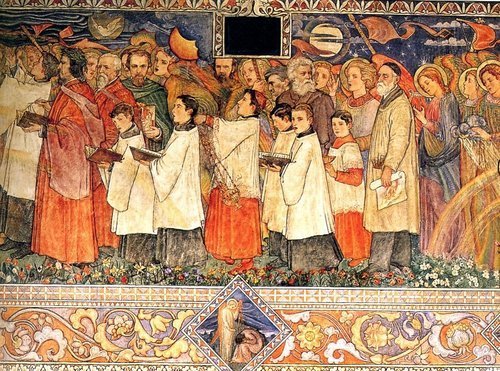
On the north wall birds and choristers sing together, and the west wall shows the four beasts singing the Sanctus. The Song School is still used daily for practice by the Choristers.
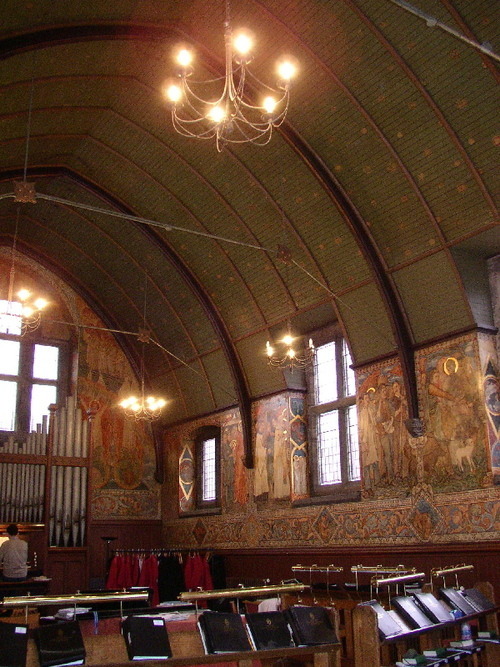
Traquair’s best known work and quite likely her masterpiece is in the vast former Catholic Apostolic Church (1893–1901) which has been called “Edinburgh’s Sistine Chapel”, and “a jeweled crown”. It was this work which helped to confirm her international recognition. The de-consecrated church is now the Mansfield Traquair Centre. The marvelous collection of murals is not well-known to tourists because the building it is only open to the public one Sunday afternoon per month.
Traquair spent eight years on these murals, doing hardly any preparatory drawings before sketching the figures directly onto the walls. This is a particularly stunning achievement given the curved surfaces of the chapel ceiling.
The Catholic Apostolic Church, founded in 1835, basically cherry-picked their favorite bits from the Anglican, Roman Catholic, and Eastern Orthodox traditions, so at a Catholic Apostolic service you would find vividly colored vestments and incense, but but no crucifixes (why dwell on Christ’s suffering when you can celebrate his resurrection?). Nor would one find any Last Judgment scenes with demons dragging damned souls down into hell… again, the Last Judgment was to be portrayed as a day of celebration.
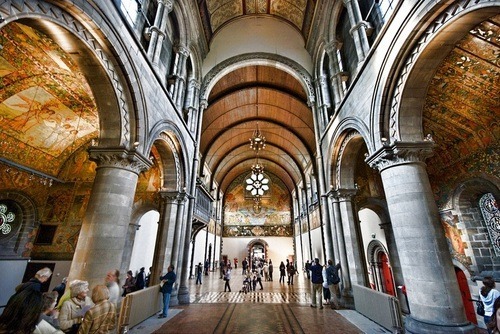


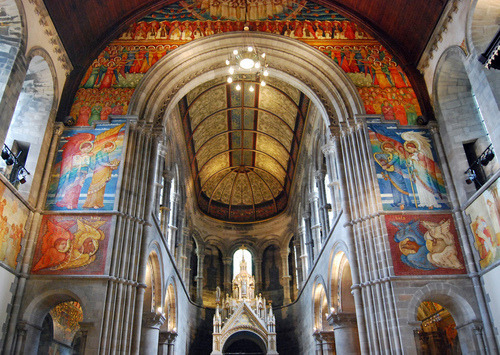

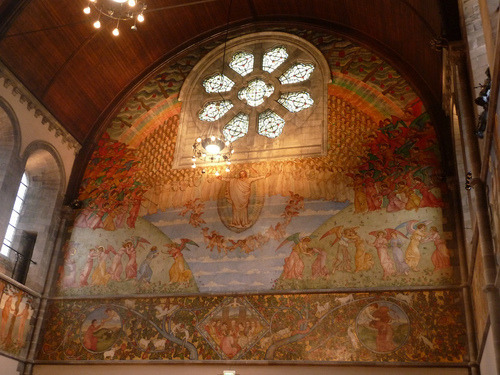
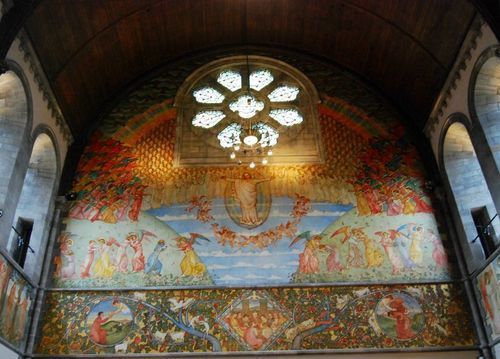
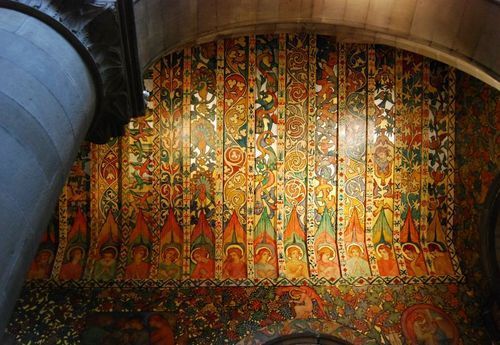
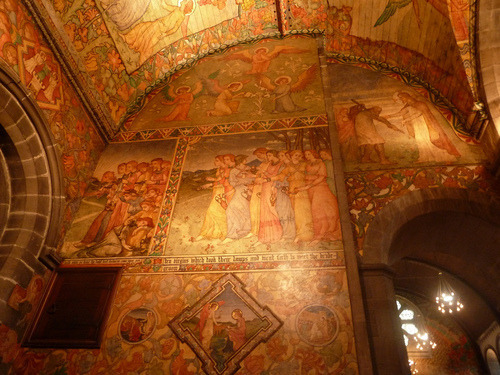
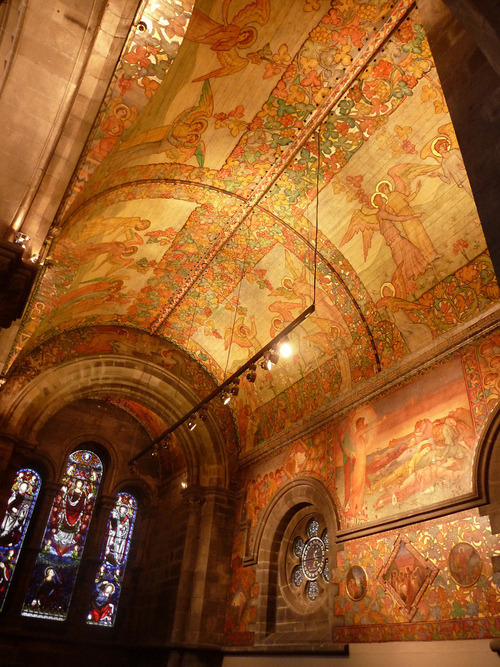
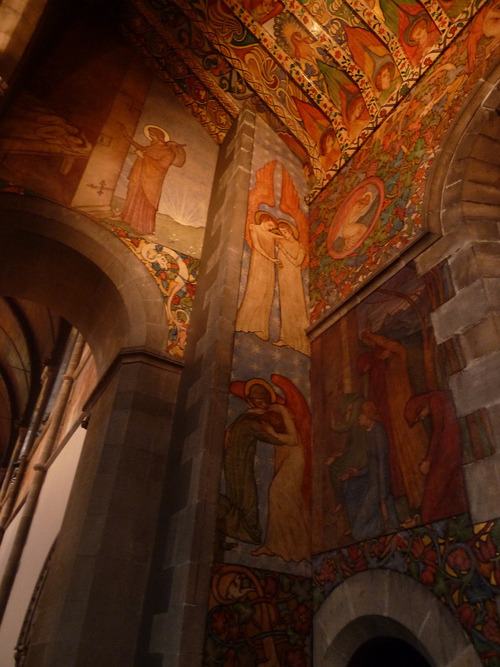
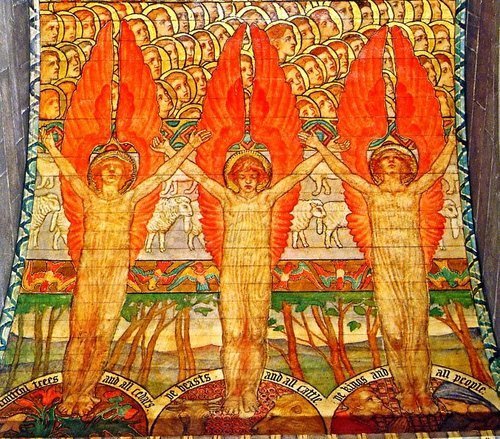
Personally, I cannot help but envy the artist who need not deal with gallery directors, the whims of collectors, and the games of the contemporary art world… but instead was given the opportunity to spend an extended period of time employed upon a work worthy of her talents and ambitions… and a work of such a scale and purpose as to inspire the artist to rise to the challenge.
Because Traquair refused to accept the traditional boundaries of “fine” and “applied” art she was refused membership of the Royal Scottish Academy, and it was not until 1920 that she was elected an honorary member. It seems the notion of a hierarchy between “fine” and “decorative” art existed even then.
Traquair died in Edinburgh on August 4, 1936 and was buried at Colinton parish church.
33 notes
·
View notes
Photo
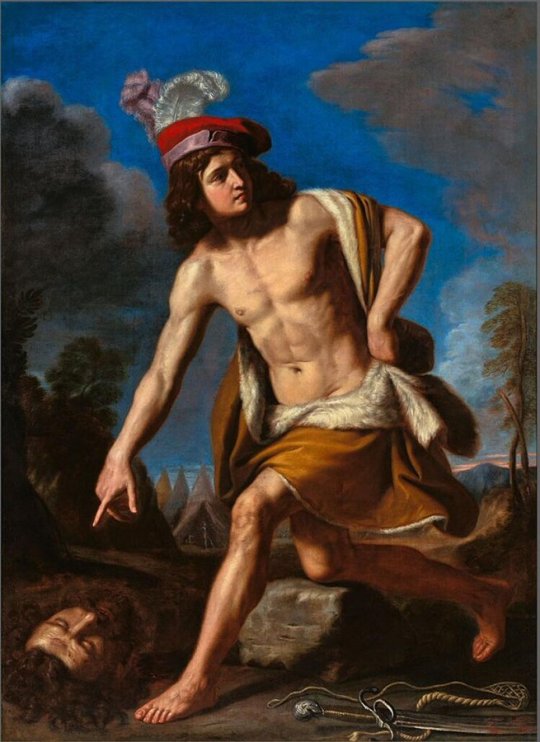
David coa cabeza de Goliat por Il Guercino, 1657.
32 notes
·
View notes
Photo
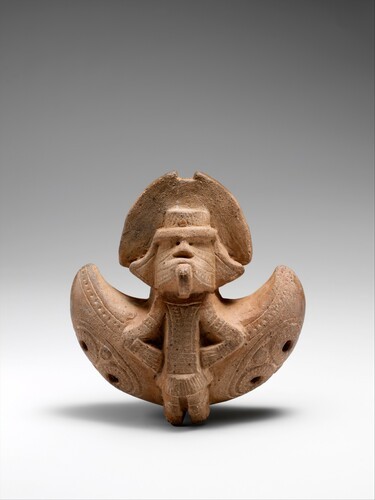
Ocarina, 1300–1500, Musical Instruments
Gift of Roberta Lee Boxer, 1984
Size: L. 10.2 cm (4 in.); W. 9.2 cm (3-5/8 in.)
Medium: Ceramic
https://www.metmuseum.org/art/collection/search/503250
8 notes
·
View notes
Photo
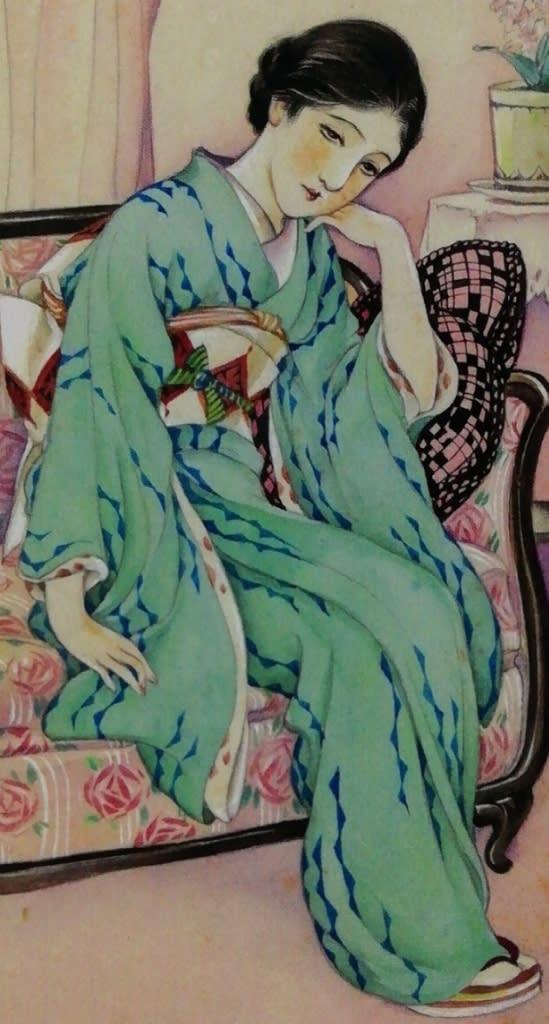
“Pink Room”. Taishō period (1912–1926) illustration. Artist: Kashō Takabatake
69 notes
·
View notes
Photo

Serena Malyon aka Nimbus2005 (Canadian, based Calgary, Alberta, Canada - Awakening (Night and Day in perpetual Embrace), 2021, Painting
7K notes
·
View notes
